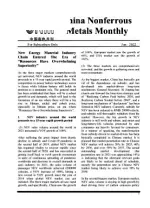China’s Mineral Exploration Market Downturn Causes Decline of Investment in Bauxite
2014-08-15
According to a survey report conducted recently by China Geological Survey Development Research Center, in the first half of 2014, China’s mineral exploration market continued to decline, with the investment in exploration of non-fuel minerals dropping by 13.7% and drilling workload dropping by 21.7%.
According to statistical analysis of the Center,in the first half of 2014, the total investment in non-fuel mineral exploration was RMB10.697 billion, down by RMB1.695 billion on a yearon-year basis. Of which, the fiscal investment from the central government was RMB1.269 billion, accounting for 11.9%, down by 8%;local fiscal investment was RMB3.494 billion,accounting for 32.6%, down by 8.1%; the private investment was RMB5.934 billion,accounting for 55.5%,down by 17.7%.
According to the report, most investments in mineral exploration are still made in the western region of China, and the reductions of investment in Hunan, Xinjiang, Inner Mongolia, Yunnan and Anhui are relatively large. The total investment in China’s western region is RMB6,582 million, accounting for 62%,down by 12.1%;the investment in central China is RMB2.4 billion, accounting for 22%,down by 22.4%; and the investment in eastern China is RMB1,582 million, accounting for 15%, down by 3.6%. The top 5 provinces(autonomous regions)of China in terms of total investment in mineral exploration are Xinjiang,Inner Mongolia, Qinghai, Yunnan and Gansu,which invest RMB1,423 million, RMB893 million, RMB831 million, RMB690 million and RMB632 million respectively. The investments of most provinces in mineral exploration declined on a year-on-year basis,of which the investments in Hunan, Xinjiang,Inner Mongolia, Yunnan and Anhui dropped significantly by over RMB200 million.
According to the report, the investments in mineral exploration are mostly important minerals and have been reduced to varied degrees. The investment in coal was RMB224 million, down by 35.2% year on year; the investment in iron ore was RMB1,095 million,down by 2.8% over the previous year; the investment in copper ore was 1,592 million,down by 0.3% year on year; the investment in lead zinc ore was RMB941 million, down by 10.7%year over year;the investment in bauxite was RMB162 million, a y-o-y decrease of 38.6%; the investment in tungsten ore was RMB141 million, down by 15.6% over the previous year; the investment in tin ore was RMB52 million, down by 46.9% year over year; the investment in molybdenum ore was RMB155 million,down by 23.3%year on year;and the investment in gold ore was RMB1,841 million,down by 9.6%year on year.
According to the report, China has completed a total of 6.38 million meters of drilling workload of non-fuel mineral exploration,down by 21.7% over last year. Particularly, the drilling workloads in Anhui, Shanxi, Hunan,Inner Mongolia, Shandong, Henan and Xinjiang declined by more than 100,000 meters. The drilling workloads of important minerals include 1,897,000 meters of coal,down by 32.9%; 601,000 meters of iron ore,down by 35.1%; 663,000 meters of copper ore,down by 2%; 503,000 meters of lead zinc ore,down by 2%; 207,000 meters of bauxite, down by 18.8%; 1,087,000 meters of gold ore, down by 11.7%.
It is reported that, since 2002, especially in recent years, China has kept increasing its investment in geological exploration and specialized fields in various degrees. After 10 years of rapid development.China’s investment in non-fuel geological exploration reached its summit of RMB51 billion in 2012, and fell for the first time in 2013, down by 8.4% over 2012.
The survey report also shows that,the funds for geological exploration of 90% of the sampled geological exploration organizations declined,and that of some organizations even fell by over 50%. “As is seen from the 13.7% decline in the first half of 2014, the downward trend continues and there is currently no sign of rapid improvement in the year. However, as the works evolve in the second half of the year,it is estimated that the investment will decline by 7-8%in the year.”
杂志排行
China Nonferrous Metals Monthly的其它文章
- Wang Jiahua: China’s Rigid Demand For Mineral Resources Will Continue to Grow For 15~20 Years
- Hangzhou Jinjiang Group Shanxi Fusheng Aluminum Phase I 800,000 t/a Aluminum Oxide Project Started Operation
- Development and Application of New Materials for Copper Processing in China
- China’s Output of Secondary Metals in the First Three Quarters Grew by 2% in Comparison With the Same Period Last Year
- Tongling Nonferrous Metals Raised Nearly 4.5 Billion to Expand Copper Concentrate Reserve
- Rare Earth Rectification Campaign Obtained Special Instructions from Officials of the State Council, 1+5 Plan Intensified Shuffling
